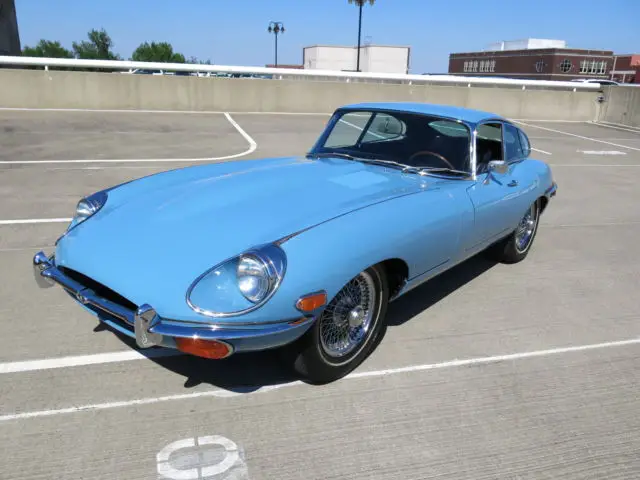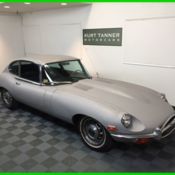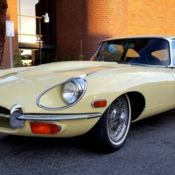|
We are proud to offer this 1969 Jaguar XKE 4.2L Series II Coupe ... This XKE has been driven on a regular basis and always stored indoors. It has been owned by 4 owners since new, all of which lived within 100 miles of where the car was originally purchased. I had the car gone through mechanically and fully serviced. It drives exceptionally well and is very original. It is very well optioned and is presented as it was built - the exterior color is correct, as is the interior and the factory installed options.
These XKE's have always been the favorites of collectors, and have steadily increased in value over the years. They continu to hold a very strong status as solid collectibles. Don't miss this chance to own this fantastic example!
Additional Details: (VIN: 1R25974), Light Blue (Glasurit # JAG-507 - first year this color was available) / Dark blue leather & carpeting, 46,380 indicated miles (believed original), 4-spd. manual trans. This Jaguar E-type was purchased by Dr. Don Pruitt, a Louisville physician, on 10/29/1969 from Koster-Swope Imports in Louisville, KY. Dr. Pruitt has been a longtime client of my company and has maintained homes here in Evansville, IN and Lexington, KY over the years. I have recently spoken to him about this vehicle and obtained some history and background about the original purchase and subsequent owners. He related that in 1969 he was living in Louisville, KY and dating his (now) wife, and at the time was driving a 1968 Corvette convertible. He was visiting his girlfriend and her parents and left in their vehicle to run an errand. As he drove by the Jaguar dealership he spotted this XKE coupe and pulled into the lot. He and a salesman struck a deal for the XKE and the dealership took his Corvette on trade without even seeing it. He left and returned to his girlfriends parents house and the dealership delivered the Jaguar to him there later in the day. He related that under his ownership the XKE was never damaged or painted and was always dealer serviced. He used it as a daily driver for about 4 years. The next owners were Ronald and Roberta Brown, who purchased the Jaguar from Dr. Pruitt sometime in the summer of 1973, with 35,528 miles. The XKE was owned by the Browns until 08/28/1976, when it was purchased by Richard Shipley of Evansville, IN for $4,500.00. We recently learned that Mr. Shipley is currently living in Texasm and we are trying to get his number from his brother and speak to him about his ownership! The most recent owner (Dr. Sloan who passed away in 2017) purchased this XKE from R.Shipley 12/11/1995 and remained in his care until his recent passing. Dr. Sloan drove the vehicle on a regular basis and there are a large stack of DMV registrations and service receipts to document ownership. We have the Jaguar Heritage Certificate report - which verifies the authenticity of this Jaguar! All of the documentation and research shows that this Jaguar is correctly presented today as it was assembled in 1969.
The documentation of this vehicle is extremely impressive, and it is rare to find an example that, through 4 owners, has remained within 100 miles of where it was originally purchased 48 year ago. We have had the vehicle serviced and inspected at Foreign Performance by a local marque specialist at a cost of over $2,000.00. The vehicle received a complete fluid and filter change, both carbs were rebuilt with new floats, and the ignition and brake systems were serviced.
This Jaguar XKE was lovingly cared for by it's most recent physician owner, was always garaged under his ownership. The body, engine, trans and factory options are all original and correct to this XKE. The paint on this Jaguar appears original, with some possible paintwork on the bonnet. The paint is excellent and has a beautiful deep shine. The glass is original and very nice with only light wiper marks on what appear to be the original windshield. The interior is exceptionally nice and the carpeting, headliner and interior trim are all excellent. The chrome is original and does not appear to have been refinished. This XKE starts easily, even cold, and drives very well. While it is not in national show condition, it is exceptionally clean and would make a perfect driver or a great basis for a complete and total restoration. Photos will give you a better idea of the condition of this vehicle, so please request and review them!
Heritage Certificate Report #49417 Information:
Make & Model: Jaguar E-type Series II 4.2L coupe
Body Style: Fixed Head Coupe, two-seater, left hand drive
Date of Manufacture: 18 March 1969
Chassis #: 1R 25974
Engine #: 7R 4597-9
Body #: 4R 21186
Gearbox #: KE 5759
Transmission: Manual
Ext. Paint Color: Light Blue
Interior Trim Color: Dark Blue
Original Distributor: British Leyland, New York, USA
Original Dealer: Koster-Swope Imports in Louisville, KY
Date of Dispatch: 23 April 1969
First Owner: Dr. Don Pruitt, Louisville, KY
Registration Mark: n/a Original factory options include:
4 speed manual transmission
Power steering
Air-conditioning & Heater
Chrome wire wheels
Disc brakes
Leather upholstery
Dual exhaust
Windshield washer
Back up lights
Tachometer & clock
Safety belts
Outside mirror
Padded dash Included with this vehicle:
Good service and maintenance history from 11/1977
Ownership history from new delivery, incl. metal registration / owners plate
Factory books and manuals, service and warranty booklets and other workshop manuals, parts catalogs, etc.
Original radio and trim surround, lots of extra parts, seals, gaskets and the original jack and leather pouch.
Second set of factory wire wheels mounted with Dunlop SP Sport tires
Jaguar Heritage certificate
Video interview with original owner
XKE Series II Production: 1969-1970 (all markets)
OTS - 8,627
FHC - 4,855
2+2 - 5,326
General:
2-door coupe body type, unitary steel monocoque w/ front steel subframe
Jaguar E-Type chain driven DOHC 4.2 Litre inline 6 cyl. (9.0:1 compression ratio)
Front mounted longitudinal Iron block with aluminium heads, two valves per cylinder
Spark ignition Lucas distributor and coil, dual Stromberg carbs and electric fuel pump
Bore: 3.62 in | 92 mm. x Stroke : 4.17 in | 106 mm.
RWD, manual 4-speed gearbox, optional automatic (2+2 only)
Horsepower: 265 @ 5,500/5,400 RPM
Torque: 260 lb-ft. @ 4,000 RPM
Fuel consumption average: 17.9 mpg
Fuel capacity: 64 liter / 16.9 U.S. gallons
Dimensions:
Length: 4,455 mm / 175.375 in.
Width: 66 inches
Height: 48/51 inches
Wheelbase: 2,438 mm / 96 in
Reference weights: base curb weight: 1,250 kg / 2,756 lbs, gross weight GVWR: 1,380 kg / 3,042 lbs
Specifications:
Weight and front / rear distribution: 49.5% front, 50.5% rear.
Wheelbase: 8 ft, front track 4 ft 2 in, rear track 4 ft 2 in, length 14 ft 7 in, width 5 ft 6 in, height 4.25 ft.
Front suspension: fully independent – unequal length A-arms, torsion bars, tube shocks, anti-roll bar.
Rear suspension: fully independent – transverse tubular and trailing links, twin coil springs and telescopic dampers each side, anti-roll bar
Brakes: hydraulic with vacuum servo.
Front: Dunlop Disc, 11 in. diameter, swept area 242 sq. in.
Rear: Dunlop Disc (inboard), 10 in. diameter, swept area 219 sq. in. (340 sq. in. per ton laden).
Steering: rack and pinion
Clutch: Borg & Beck dry plate
Hypoid bevel rear differential
Tires and wheels: Dunlop 6.40 x I6 RS5 on 72-spoke knock off wires
0-60 MPH - 7.0 seconds
Top speed - 149 MPH
The XKE Series 2 (1968 - 1971) introduced a number of design changes, largely due to U.S. design legislation. The most distinctive exterior feature is the absence of the glass headlight covers, which affected several other imported cars, like the Citroen DS, as well. Unlike other cars, this retrograde step was applied worldwide for the E-Type, not just to Americans living under the authority of the National Highway Traffic and Safety Administration.
The Series 2 4.2-liter cars that were sold for 1969, 1970 and into 1971 were distinguished with larger front marker lamps and taillamps below raised bumpers, added side marker lamps, forward-set headlamps and a larger air inlet "mouth." Safety considerations also meant that, following 1968's rocker switch substitution, the steering column was made collapsible and headrests were added. A steeper-raked windshield on 2+2 models brought more glass but fewer (only two) windshield wipers. A glovebox door on all models (formerly only on 2+2s), perforated leather upholstery and newly optional power steering improved interior accommodations. New seats were fitted which allowed the fitment of head restraints, as required by U.S. law beginning in 1969. The interior and dashboard were also redesigned; rocker switches that met US health and safety regulations were substituted for toggle switches. The dashboard switches also lost their symmetrical layout. Air conditioning and power steering were available as factory options.
Under the bonnet of all U.S.-spec Series 2 E-types, two emissions-friendly Zenith-Stromberg 175 CD2SE carburetors, along with other new pollution-reducing controls, meant the cars made a bit less power: 246hp at 5,500 RPM and 263-lbs ft of torque at 3,000 RPM. These long-legged Jags still had plenty of poke, though, with the automatic-equipped 2+2 reaching 100 MPH in 22.7 seconds. The engine is easily identified visually by the change from smooth polished cam covers to a more industrial "ribbed" appearance. It was de-tuned in the US with twin Strombergs and larger valve clearances, but in the UK retained triple SUs and the much tighter valve clearances. (Series 1.5 cars also had ribbed cam covers). This detuned engine produced 245 hp (183 kW), a drop of 20 hp.
Sports car enthusiasts are typically divided on which generation of E-Type they prefer, but most agree that the Series 1 cars are the sportiest and purest in design. Although some gravitate towards the flat-floor 1961s, "The most popular E-Types are the [4.2-liter] 1965-1967s," says Jason Len, owner of XKs Unlimited. "But the things that make them better--the transmission, cooling system and brakes--can all be upgraded on the 3.8, too."
The Jaguar Club of North America is an excellent resource for new E-type owners, as explained by longtime JCNA board member Tom Krefetz. "Everything JCNA does is to inform and support members, maintain judging standards and promote Jaguar's heritage. The E-type got a lot of press for its 50th anniversary, and it's woken up the world to what a great car it is," he says; "It's become more valuable and sought-after, as it should be--it's a unique design that was so ahead of its time."
Body
Jaguar built E-type bodies wholly of 20-gauge mild sheet steel, and those complex monocoques make serious rust repair a complex job. Brian Donovan of Donovan Motorcar Service says, "I tell customers that the condition of the bodywork is the most important factor in finding an E-type. Repair work can make a car look good, but if it's not done properly, you've got a problem, because most body shops don't know the intricacies of these cars." He notes that rust in the sills, the sill stiffeners and end plates, and in the floorpans causes structural weakness, and that front and rear body alignment must be kept in spec. "The front frame can also rust from the inside, causing the side members to crack," Brian adds; "Coupes are stronger because their floors and inner sills last longer."
Rust doesn't mean an E-type is junkyard fodder, though. "Body parts are available for all series of E-types," says Tom Krefetz, owner of E-type specialist firm Classic Showcase. "Reproduction body parts are typically good. Martin Robey, the main supplier in the U.K., has all of the original jigs and sheetmetal tooling."
Interior
The fact that six-cylinder E-types were built in the era before electronics came into widespread use means that their interiors are simple to restore back to original specifications. A number of specialists offer kits to renew the leather seating, vinyl interior panels and the carpeting. Parts availability is very good, although there are a few issues for the purist. Tom explains: "On 1961-early 1962 [cars], they used a special dot pattern for the aluminum console trim; that was then changed to a cross-hatch pattern, and the early tooling has never been duplicated like the later was. If you're going for 100-percent originality, you may not be able to make a perfect car, but it's acceptably close."
Later cars' factory-optional air conditioning is very effective, thanks to its powerful Tecumseh compressor. Custom components often increase comfort and usability, like Welsh Enterprises' OEM-style 15-inch diameter wood steering wheel. "It has a thicker grip and is one inch smaller, so you don't bump your knees when you get in," adds David Welsh of Welsh Enterprises.
Engine
The long-lived, much-loved XK six-cylinder engine is a very highly regarded unit, regardless of displacement. The 3.8-liter version is prized for its raw, revvy nature, while the 4.2-liter version is torquier and has a more relaxed disposition. Both are very sturdy units that can be bored and sleeved as necessary, and virtually all mechanical components needed to keep an XK engine running are available today. The E-type's reputation for overheating came from tired cooling systems; fitting a high-efficiency aluminum radiator with upgraded fans and thermostat will guarantee cool running in every condition. Electrical gremlins, if present, can be sorted with a bit of time and patience.
The 3.8 and 4.2 respond well to performance modifications, and while the Series 3 V-12 can be taken further in terms of ultimate power, the compact six-cylinder engine allows for more nimble handling. Today's ethanol-laced gasoline has less of a chance of eating into Welsh Enterprises' galvanized version of the stock steel gas tank.
Transmission
The E-type used three transmissions in its first decade: the Moss four-speed manual with an unsynchronized first gear (1961-1963); the fully-synchronized Jaguar four-speed manual (1964-1970); and the Borg-Warner Model 8 three-speed automatic (2+2, 1966-1970). While the Moss unit has a reputation for being stiff and a bit clunky, all of these gearboxes are notably durable, and parts are readily available should a rebuild be required.
Manual transmission clutch engagement can feel heavy to the uninitiated, and clutch replacement, if required, is an engine-out job. Automatics are known to leak, and may require new seals. A five-speed manual, sold in kit form, is a surprisingly simple and pleasant substitution that improves performance and fuel economy. "We carry one based on the Cosworth, and it's specifically designed and built for these cars," David notes. "You have to recalibrate the speedometer and alter the driveshaft, but other than that, it bolts right in."
Aiding traction, a sturdy limited-slip rear differential was standard equipment on all E-types.
Brakes and Suspension
Part of the E-type's advanced nature was its fully independent suspension and racing-derived four-wheel disc brakes, the rears, located inboard, on either side of the differential, to reduce unsprung weight. Steering was by rack and pinion. The sub-frame mounted front suspension's transverse upper and lower wishbones, torsion bars, Girling Monotube shocks and anti-roll bar and the cage-mounted rear suspension's lower wishbones, radius arms, two coil spring-over-tube shocks per side and a rear anti-roll bar combined to give this Jaguar a remarkable combination of supple ride and sharp handling.
Stock suspension and brake components are all a phone call away, and upgraded components are readily available, too. The suspension cage design limits the ultimate size of rear discs that will fit, but sharper handling can come from fitting urethane bushings, and rust-proof stainless steel caliper pistons can be retrofitted to cars that aren't regularly driven to prolong brake system life.
Bid with confidence - we have been a member of eBay since November 1998 and we have a 100% feedback rating!! We do have a complete collection of photographs that document every aspect of this vehicle, so please request them! And be sure to mail us if you have any questions! Please also keep in mind that this vehicle is being advertised via other retail venues, so we reserve the right to cancel this auction at any time and without notice.
God bless and good luck in bidding!
*This vehicle is located in Southern Indiana - more information or photographs are available upon on request. While every reasonable effort has been made to ensure the accuracy of the description of this vehicle, mistakes regarding hp ratings, options, etc. can be made. I have also done my best to be very honest and very critical about the cosmetic and mechanical condition of this vehicle. Of course, it is not always possible to pick-up on every minor detail or flaw. Please keep expectations realistic as this is a pre-owned vehicle, and I have personally found blemishes on brand new un-driven vehicles. If you are an exceptionally detailed oriented person, please contact me to verify any information directly, and I will do my best to specifically photograph anything you request and to answer any of your questions to the best of my ability.
|
 Home
Home Contact us
Contact us NEWEST CARS
NEWEST CARS SELL YOUR CAR
SELL YOUR CAR FAQ
FAQ



















